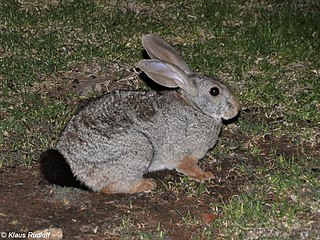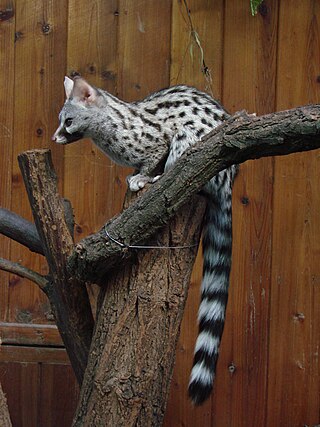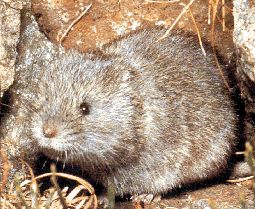
The eastern cottontail is a New World cottontail rabbit, a member of the family Leporidae. It is the most common rabbit species in North America.

The riverine rabbit, also known as the bushman rabbit or bushman hare, is a rabbit with an extremely limited distribution area, found only in the central and southern regions of the Karoo Desert of South Africa's Northern Cape Province. It is the only member of the genus Bunolagus because of unique traits that separate it from the other leporids. It is one of the most endangered mammals in the world, with only around 500 living adults, and 1500 overall.

The pygmy rabbit is a rabbit species native to the United States. It is also the only native rabbit species in North America to dig its own burrow. The pygmy rabbit differs significantly from species within either the Lepus (hare) or Sylvilagus (cottontail) genera and is generally considered to be within the monotypic genus Brachylagus. One isolated population, the Columbia Basin pygmy rabbit, is listed as an endangered species by the U.S. Federal government, though the International Union for Conservation of Nature lists the species as lower risk.

Jameson's red rock hare is a leporid found only on the continent of Africa, mostly in the southern portion of the continent. Zimbabwe and Namibia are thought to have the largest populations of the red rock hare and it is said to be found throughout both countries. South Africa has a population of this red rock hare but it is only found in the northwestern part of the country. Botswana also has a population in the Tswapong Hills.

A genet is a member of the genus Genetta, which consists of 17 species of small African carnivorans. The common genet is the only genet present in Europe and occurs in the Iberian Peninsula, Italy and France.

The crested servaline genet, also known as the crested genet, is a genet species endemic to Nigeria and Cameroon. As the population has declined due to loss of habitat, it is listed as Vulnerable on the IUCN Red List. It was first recorded in the Mamfe Division in Cameroon and initially considered a subspecies of the servaline genet. But now it is regarded as a distinct species.

The servaline genet is a genet species native to Central Africa. As it is widely distributed and considered common, it is listed as Least Concern on the IUCN Red List.

The common genet is a small viverrid indigenous to Africa that was introduced to southwestern Europe. It is widely distributed north of the Sahara, in savanna zones south of the Sahara to southern Africa and along the coast of Arabia, Yemen and Oman. It is listed as Least Concern on the IUCN Red List.

The northern pika is a species of pika found across mountainous regions of northern Asia, from the Ural Mountains to northern Japan and south through Mongolia, Manchuria and northern Korea. An adult northern pika has a body length of 12.5–18.5 centimeters (4.9–7.3 in), and a tail of 0.5–1.2 centimeters (0.20–0.47 in). The pika sheds its fur twice annually, bearing a reddish-brown coat in the summer and grayish-brown coat in winter. It feeds on various plant material and makes "hay piles" for winter use.

The Cape genet, also known as the South African large-spotted genet, is a genet species endemic to South Africa. As it is common and not threatened, it is listed as Least Concern on the IUCN Red List. Like other genets, it is nocturnal and arboreal, preferring to live in the riparian zones of forests, as long as these are not marshy areas.

The Hausa genet is a genet species native to West African savannas. It is listed as Least Concern on the IUCN Red List.

The European snow vole or snow vole is a species of rodent in the family Cricetidae. It has dense, pale grey fur and a pale-coloured tail and can reach about 14 cm (5.5 in) long, with a tail which is 7 cm (2.8 in) long.

The wildlife of Zambia refers to the natural flora and fauna of Zambia. This article provides an overview, and outline of the main wildlife areas or regions, and compact lists of animals focusing on prevalence and distribution in the country rather than on taxonomy. More specialized articles on particular groups are linked from here.

The Helan Shan pika or silver pika is a species of mammal in the pika family, Ochotonidae. It is endemic to China where it is found in a small region of the Helan Mountains. It is listed as "Endangered" in the IUCN Red List of Threatened Species as of 2016.

The Natal red rock hare or greater red rock hare is a species of mammal in the family Leporidae. It has a slightly grizzled, grayish brown head and reddish brown upperparts. The dense fur is thick and rougher than other rock hares. It is endemic to Africa, and found in southeastern provinces of South Africa, eastern Lesotho, Eswatini, and southern Mozambique. It is a herbivore, primarily feeding on grass. It breeds throughout the year, and one or two pups are usually born in the summer. It is rated as a species of least concern on the IUCN Red List of Endangered Species.
Erindi Private Game Reserve is a wildlife and ecological reserve in central Namibia, situated southeast of Omaruru on the regional border of Erongo and Otjozondjupa. Originally a set of three adjacent cattle farms, the 65,000 hectares estate was converted into a wildlife reserve starting in the 1990s.

















